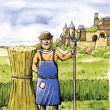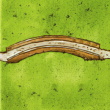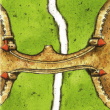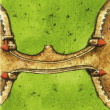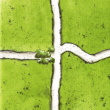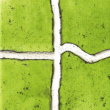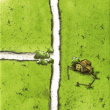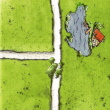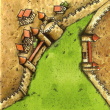Cleric and Serf (Fan Expansion)
Please note that WikiCarpedia is not responsible for the content of the links provided. The listed expansions are subject to the regulations of the corresponding websites.
In general, however: The use of the fan expansions for commercial purposes is not allowed. The Fan-Expansions may only be produced for personal use and may not be sold at any time. This also explicitly includes the passing on at cost price.
General info and comments
The Cleric & Serf fan-expansion was released by Carcassonne Central member Novelty, with assistance by Scott and based upon an original idea by Christoph Berger. It is analogous to the mini-expansion King and Robber Baron, and it is recommended, though not required, that you play the two expansions together.
The tiles and rules files are available here (please register to access):
Contents
- 10 new land tiles
- 14 cloister tokens
- 1 cleric tile
- 1 serf tile
Rules
Preparation
- Shuffle the new land tiles together with the land tiles of the basic game.
- Place the cleric and serf tiles, as well as the cloister tokens, next to the scoring track.
Gameplay
1. Placing a tile
The new land tiles are placed in the usual way. Take care with the following tiles.
2. Placing a meeple
As soon as a player plays the barn, he or she should take the Serf tile. Note the total number of farmers that are removed when the barn is placed. If, during the course of play, another barn is placed which removes more farmers than when a barn was previously placed, the player who played the barn takes the serf tile.[1]
3. Scoring a feature
As soon as a player scores the first cloister, he or she should take the cleric tile. If, during the course of play, another player scores more cloisters, then that player receives the cleric tile.
The player that completes a cloister receives a cloister token, provided that there is still a spare cloister token in the supply. This player may not be the same player that scores the cloister.

Final Scoring
At the end of the game, before the farms are scored, the player in the possession of the Serf tile scores 1 point for every farmer[2] remaining in the game and 5 points for every barn that has been played.
At the end of the game, the player in possession of the Cleric Tile scores 10 points. The player in possession of the cleric also scores 3 points for every completed city with a cathedral and 2 points for every abbey played. In the event that the player holding the cleric is involved in a tie for the total number of cloister counters collected, the cleric breaks ties in favour of the player holding the cleric.
The player who has collected the most Cloister counters scores 10 points. As usual, in the case of a draw all players involved score the full 10 points, unless one of the players involved is holding the cleric, in which case, the player with the cleric gets 10 points.
Tile distribution
Footnotes
For Icons explanation and licensing please visit Icons page.
- ↑
 If you are not playing with the Abbey & Mayor expansion, the first player to place a farmer should take the Serf tile. If, during the course of play, another player establishes a larger farm (according to the number of followers on that farm) then he or she receives the Serf tile.
If you are not playing with the Abbey & Mayor expansion, the first player to place a farmer should take the Serf tile. If, during the course of play, another player establishes a larger farm (according to the number of followers on that farm) then he or she receives the Serf tile.
- ↑
 This is the total number of farmers for all players.
This is the total number of farmers for all players.


